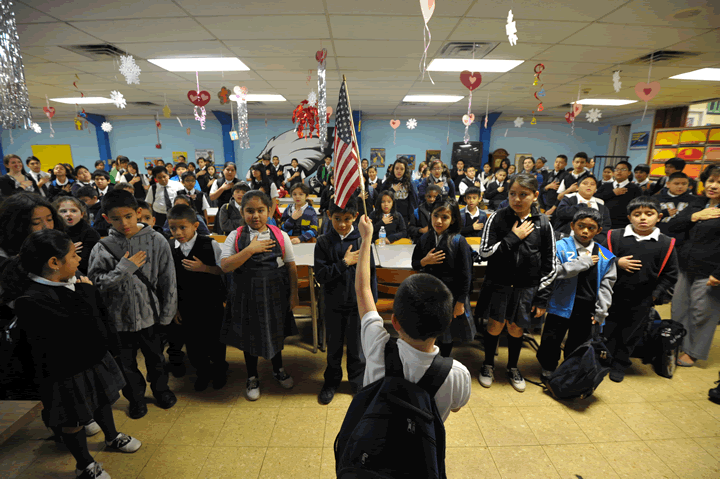About a week and a half ago, right around the time most of our nation's schools were gearing up for another school year, the Catholic news site Crux published a helpful story, "Catholic schools look to tax credits to save them" by Michael O'Loughlin.
OK, so the headline is a little ominous.
On the one hand, even if tax credits magically became legal in every state in the union, many Catholic schools wouldn't necessarily be off the proverbial "chopping block"-they'd still need strong and robust community engagement to increase enrollment, excellent instruction, high academic standards, and so forth. But on the other hand, if all tax credit and voucher laws were to suddenly evaporate, it wouldn't necessarily be the end of the world for the Catholic educational system either. Indeed, advocates of Catholic education have a few others ideas that, together, we hope, will continue save our schools (e.g., excellent teachers, transformational leaders, the Holy Spirit).
What the article does do is give a pretty concise overview of where school choice stands in many states, in particular New York. O'Loughlin then explains how these policies-school choice programs, vouchers, tax credits-help families with kids in Catholic schools as well as the schools themselves.
The fascinating thing about what's happening in New York is that you have Cardinal Timothy Dolan standing side by side with Gov. Andrew Cuomo on what, in some circles, is a pretty divisive political issue. These two haven't always seen eye-to-eye on every issue, but when it comes to school choice, they're in lock-step.
I sat down with ACE's Director of Education Policy, and asked him: What's up with that? In other words: What is it about school choice that has a Catholic cardinal and a democratic governor joining forces?
Schoenig offered a few thoughts.
Educational Choice is Good For Everyone
The most interesting (and what Schoenig calls the most "elegant") part of the Education Tax Credit (ETC) and programs like it is that it will help support education in all three educational sectors: public, charter, and private. In the Empire State, nearly $40 million would go directly back to public school support (after school programming, instructional materials, supplies, etc.) more than $50 million would fund scholarships for low-income students, and $70 million more would come back to families in the form of tax credits that allow them to send kids to the school of their choosing. The design of the bills like these as a "tri-sector" credits expands the conversation from simply helping private schools specifically to broadening educational choice overall.
 There are Significant Financial Benefits
There are Significant Financial Benefits
While opponents of educational choice often position the issue in terms that vilify tax credit "schemes" designed to "siphon" money away from public schools, they miss the mark on several fronts. Most importantly, such arguments presume that the primary function of education spending is to support a pre-existing infrastructure - rather than to serve children. In addition, they fail to acknowledge that choice programs (including both private school choice and charter initiatives) often lessen the financial strain on sometimes fragile state budgets. Given that the cost to educate in the average urban faith based school is significantly less than the cost in a traditional public school - and that the average voucher rate is lower than the allocated per pupil spending in virtually every state with private school choice - a family's decision to exercise a choice to enroll their child in a Catholic school that is subsidized by a private school choice program is a fiscal win for the state.
Catholic Schools are Essential to Communities
If all of the Catholic schools in New York or Chicago or Philadelphia were to suddenly disappear, you'd very quickly have educational systems on par with those seen in a third-world country. Schoenig explained: you'd have a ton of elite schools filled with kids from wealthy families, but for those students in low and middle-income situations, it wouldn't look good. New York isn't hurting for quality educational options-if you're wealthy. Both the abundance and quality of educational options for rich people keeps getting better every year. By keeping Catholic schools open and maintaining their commitment to serve low-income communities, Catholic schools play a vital role not just in major cities, but all across the United States.
Of course, school choice policies work best when all of the schools in all three sectors-public, charter, and private-are continuously improving and held to the same set of high standards. And if schools (public or private) are receiving taxpayer money, they need to be held accountable for how they use that money. After all, choice only matters insofar as you're choosing among quality things. But that's a blog post for another day.
In the meantime, will tax credits "save" Catholic schools? Not necessarily. But they might save one child, or one family, or even an entire community from a cycle of poverty. And that's probably the biggest reason you'll only continue to see more people from all types of places-governors' mansions to cardinals' chairs-continue to fight for choice.
 Alliance for Catholic Education
Alliance for Catholic Education
